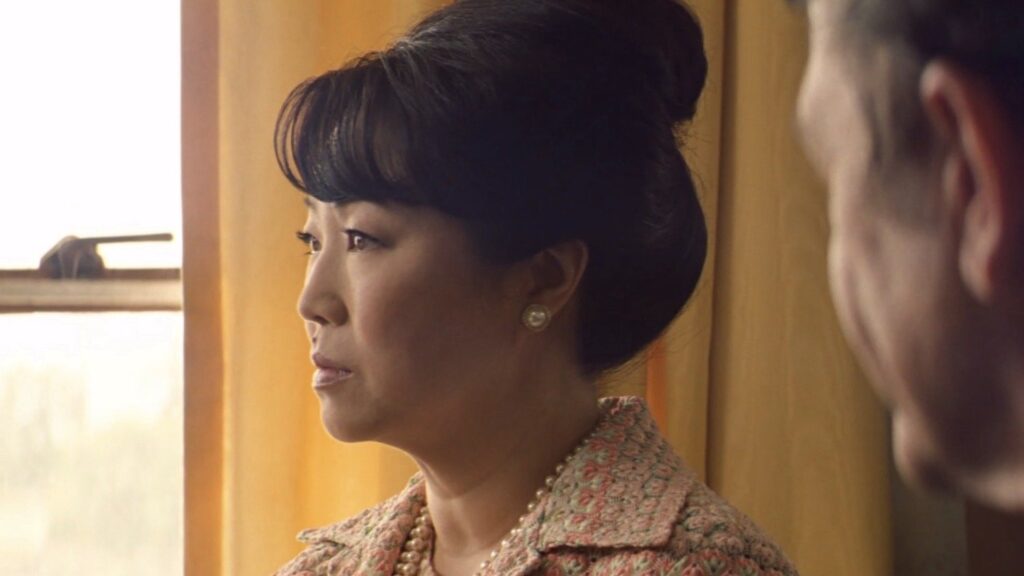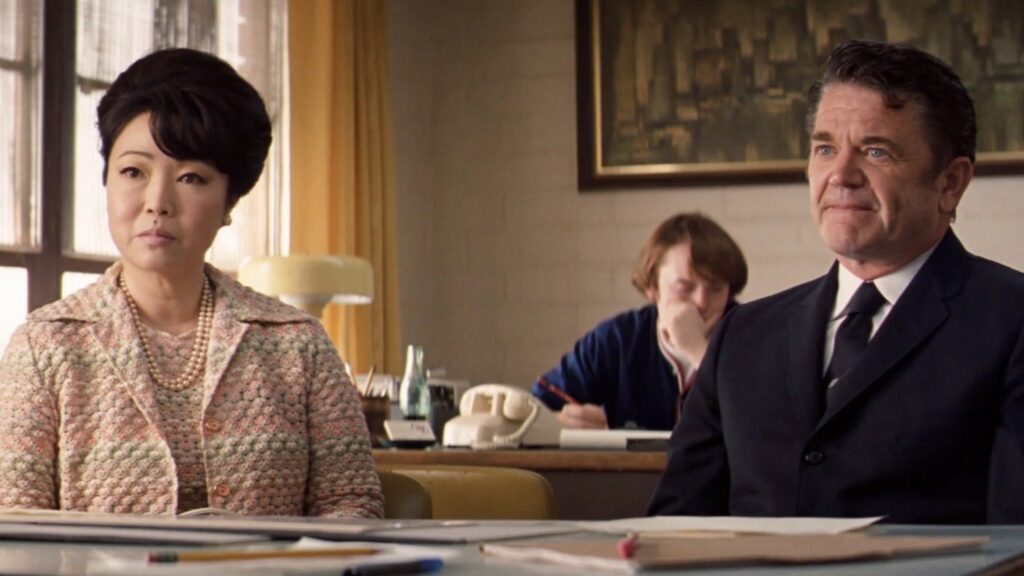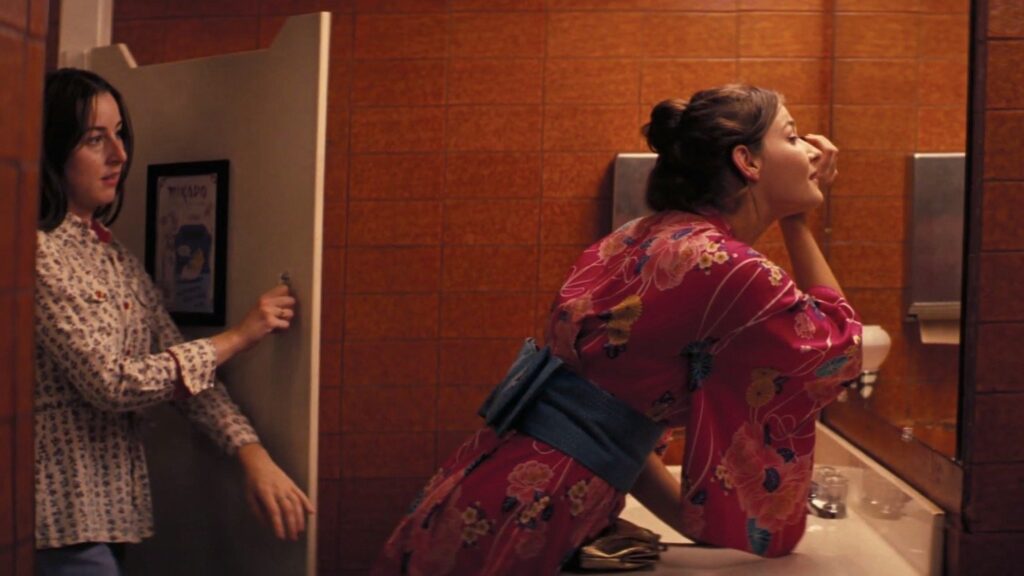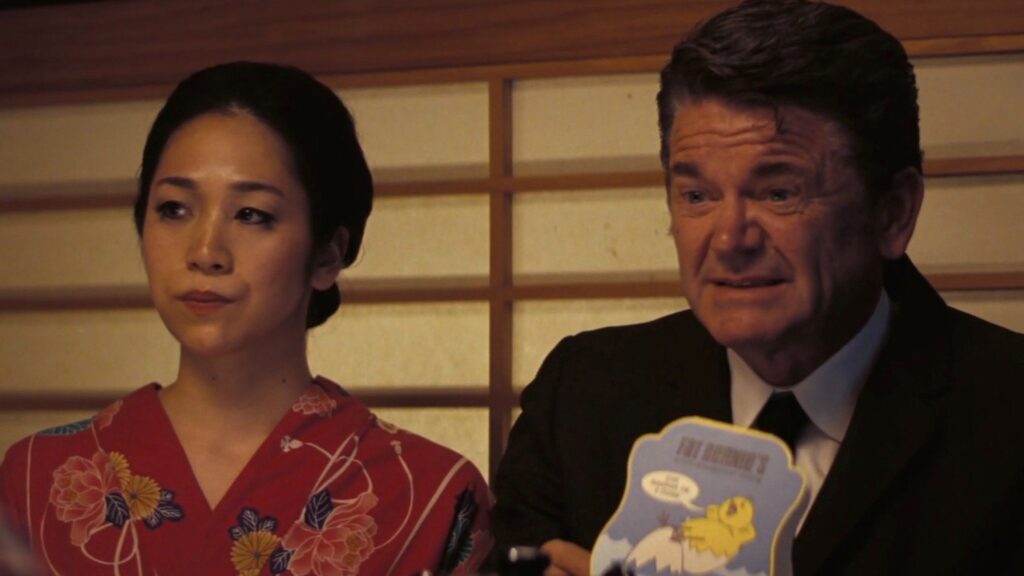| Anjali Moore |

Licorice Pizza plays on phenomenal 70mm at the Heights Theater on Monday, March 31st. For tickets, showtimes, and other series information, visit trylon.org.
Since I have always held a compulsive devotion to 1970s media and coming-of-age films, I ventured to the cinema to see Licorice Pizza with relatively high hopes when it was first released in 2021. I felt like Licorice Pizza might pierce my general disaffection for PTA but instead I was left with the distinct sense of disappointment one feels when a film pales in comparison to your expectations. The movie made me angry and uncomfortable, but not in a positive or constructive way. Its excellent soundtrack and 70s period elements were winning factors for me, but were not enough to make me ignore its thread of gratuitous anti-Asian racism and the unshakeable sense that the film was primarily designed for white audiences. Whenever I sense this during a viewing experience it leaves a bad taste in my mouth, but with Licorice Pizza this bitterness has only soured over time.

The first scene in question depicts a white restaurateur named Jerry and his Japanese wife Mioko going over publicity content with the mother of the protagonist, Gary Valentine. The press copy frames Mioko as Jerry’s “attractive young wife” and the restaurant as “quite authentic, for Jerry had a restaurant some 15 years in Tokyo.” Both of these statements immediately paint Mioko in a diminutive light: as a woman of color being superseded by a white man. It strips all authenticity and cultural authority from Mioko, ascribing it to Jerry instead. The copy goes on to state that “the entire staff with the exception of Jerry is Japanese.”
This statement is later contradicted in a moment of somewhat uncomfortable cultural appropriation, when the film’s love interest, Alana, runs into one of the restaurant’s white waitresses working in Japanese dress. One of the last phrases of the copy is “those little doll-waitresses are dressed fittingly in colorful kimonos” which elicits an immediate look of disdain from Mioko while Jerry exclaims, “That’s wonderful!” Mioko is upset—but the audience can only tell through her facial expression. She does not speak until Jerry addresses her by way of launching into an overblown and tedious fake Japanese accent.

The accent itself is offensive and incredibly difficult to watch, but even more troubling is how Mioko is constructed within the framework of Orientalist attitudes toward Asian women as docile and submissive. She speaks back to Jerry in a composed, stern voice in Japanese, yet her words are not subtitled, which effectively silences her. Because Licorice Pizza is already so distinctly white and Western, the choice to exclude subtitles is even more loaded as it disempowers her character, allowing white or non-Japanese language viewers to interpret her as utterly deferential to her white male husband. If her words are meant to challenge her husband, the viewer has no way of knowing. Jerry is granted the privilege of the last word.
Approximately thirty minutes later, these transgressions are compounded by another scene where Jerry has a new Japanese wife, Kimiko. Gary mistakenly calls her Mioko, falling back on the old stereotype that all Asian people look the same. He cannot distinguish between the two wives, as Kimiko was not even introduced as a different woman until after Gary’s faux pas. This interchangeability conflates all people of Asian descent into a “foreign, exotic monolith.”1 The viewer is then subjected to a second round of the same disrespectful accent and Jerry’s blatant fetishization and exoticization of Japanese women. At best, Alana’s body language and dialogue suggest her embarrassment and disapproval of Jerry’s behavior, but it is rather subtle and nevertheless contributes to an alienation of Kimiko’s character. Alana may be the only one who asks what Kimiko has actually said in Japanese, but we once again are denied the answer—instead, Jerry responds, “It’s hard to tell, I don’t speak Japanese” which seems to be meant as some sort of punch line.

While it is true that Jerry’s character is constructed as an ignorant buffoon in both scenes, the way his racist jokes are played for laughs misses the mark and just is not funny for people who actually have experience with these kinds of situations. And more importantly, no character—save for Alana’s half-hearted criticism—voices any opinion or rejection of Jerry’s reprehensible behavior. Neither scene has any bearing on the plot and appear pointedly unnecessary and egregious. The film was released in 2021 at the height of a violent wave of anti-Asian racism in the US, which accentuated how offensive its scenes of unchecked racism were publicly perceived.
Licorice Pizza may have been met with rave reviews from the public and critics alike, but an outspoken minority immediately voiced concerns over its Orientalism and aggressive whiteness. The Media Action Network for Asian Americans (MANAA) called for an awards boycott and published a powerful statement detailing how and why Anderson’s depiction of Japanese women was irresponsible and normalizes racism for white audiences. They advocated for the Academy to reject rewarding Paul Thomas Anderson for inappropriate portrayals of Asian people. Although the movie garnered over 100 nominations during the awards season, it did not win any Oscars.
The MANAA statement makes several salient points, including a quote from filmmaker, author, and media critic Anita Sarkeesian, stating, “Just showing racism isn’t a critique of racism, it is actually doing racism… It is irresponsible to throw that (the racist scenes) in as an aside without actually signaling that this is both currently AND was always bad.” This speaks to the common excuses like, “That’s how it was back in the 70s,” which is a poor attempt to absolve the sins of the film. It is insufficient primarily because racism was and is still wrong.
What I’ve found most disturbing was PTA’s response—which I was not aware of at the time—in an Indiewire interview with Eric Kohn, as follows:
EK: Now that “Licorice Pizza” has been out a while, how do you feel about the complaints that have been made about the anti-Asian character played by John Michael Higgins, who speaks in an offensive fake Asian accent?
PTA: It’s kind of like, “Huh?” I don’t know if it’s a “Huh” with a dot dot dot. It’s funny because it’s hard for me to relate to. I don’t know. I’m lost when it comes to that. To me, I’m not sure what they—you know, what is the problem? The problem is that he was an idiot saying stupid shit? What do you think?
EK: The problem is that his racism could give people permission to laugh at the stereotype, rather than his stupidity.
PTA: Right. Well, I don’t know, maybe that’s a possibility. I’m certainly capable of missing the mark, but on the other hand, I guess I’m not sure how to separate what my intentions were from how they landed.
Anderson’s initial response demonstrates a shocking lack of accountability and refusal to empathize with those he may have offended. He immediately dismisses the issue as unimportant and his admission that it is hard for him to “relate to” exposes his white privilege and inability to really understand what people of color might feel while watching those scenes. Kohn’s response is sharp and clear: many audience members laughed not at Jerry, but with him, accepting these harmful stereotypes as comedic—a sentiment felt by many and highlighted in the MANAA statement. There is not a clear enough rebuttal or commentary in either of the scenes to communicate that what Jerry did is wrong. Instead, his out-of-touch humor hangs in the air awkwardly before cutting to the next scene, acting as a tacit permission for racist behavior.
As a white male filmmaker with a major platform who is depicting a sensitive topic, Anderson has even more of a responsibility to, first, represent Asian-identifying audiences respectfully and, second, take accountability for the creative choices that resulted in painful fallout if that is not achieved. In some ways, this shirking of accountability distresses me even more than the inclusion of the scene itself, even if it is par for the course.
Although these two scenes are the most pointedly racist moments of the film, I feel that they are part of a larger problem in Western cinema wherein white women are posited as the ideal and women of color as inferior in on-screen representations. In Licorice Pizza, this ideal is not always as explicit as in the aforementioned scenes—instead, it is more discreetly woven into the fabric of the film. Viewers who are women of color may be more attuned to these moments, as being overshadowed by white women is a commonplace daily reality, both onscreen and off. For example, there are other minor moments in the film featuring non-Asian women of color in dubious ways, including one scene where a shop clerk (one of the few Black actors in the movie) is clearly designated as merely an object of sexual fantasy for Gary. Like the two Japanese wives, her character feels purely incidental and unsettlingly sexualized and objectified.
With all of these factors in mind, it is impossible to not consider this film alongside others that, while directed by white directors of indelible stature, feature superfluous anti-Asian racism and idealize white womanhood in harmful ways. That includes Lost in Translation (Sofia Coppola), Palo Alto (Gia Coppola), and SubUrbia (Richard Linklater). All three contain enjoyable elements but are overpowered by racist scenes that stick out long after the first viewing. I can and do enjoy other films by these directors but simultaneously, I feel it is imperative to address glaring issues related to race and gender in their work. As an Asian-identifying woman, I do not have the privilege to ignore these strains of racism. Being light-skinned and mixed race, I do not experience the same types of racism that monoracial people of color experience, yet I do experience other forms of racialized aggression. These types of behaviors should be deconstructed and eradicated through film rather than perpetuated and legitimized, as they are in Licorice Pizza.
Footnotes
1 Kendall Matsumoto, “Orientalism and the Legacy of Racialized Sexism: Disparate Representational Images of Asian and Eurasian Women in American Culture,” Young Scholars in Writing: Undergraduate Research in Writing and Rhetoric 17 (February 2020): 114-126
Bibliography
Jana Monji, “A Slice of Racism in Licorice Pizza?,” AsAm News, December 9, 2021. https://asamnews.com/2021/12/09/creepy-premise-and-japanese-women-just-there-to-laugh-at-bring-down-licorice-pizza
Jen Yamato, “‘Licorice Pizza’ made Asians a ‘punchline.’ And the fallout is bigger than the Oscars,” Los Angeles Times, March 23, 2022. https://www.latimes.com/entertainment-arts/movies/story/2022-03-23/licorice-pizza-racism-controversy-paul-thomas-anderson
Joshua Meyer, “Anatomy of a Controversy: Revisiting the Japanese Wife Scenes in ‘Licorice Pizza,’” The Gaijin Ghost (blog), February 21, 2023. https://thegaijinghost.com/blog/anatomy-controversy-revisiting-japanese-wife-scenes-licorice-pizza
Joshua Meyer, “Licorice Pizza Director Paul Thomas Anderson Responds To Criticism Of Fake Asian Accent,” SlashFilm, February 21, 2022. https://www.slashfilm.com/775260/licorice-pizza-director-paul-thomas-anderson-responds-to-criticism-of-fake-asian-accent/
Joshua Meyer, “Living ‘Lost In Translation’ And Examining The Film’s Global Legacy, 15 Years Later,” SlashFilm, September 12, 2018. https://www.slashfilm.com/560856/lost-in-translation-legacy/
Kendall Matsumoto, “Orientalism and the Legacy of Racialized Sexism: Disparate Representational Images of Asian and Eurasian Women in American Culture,” Young Scholars in Writing: Undergraduate Research in Writing and Rhetoric 17 (February 2020): 114-126,
https://youngscholarsinwriting.org/index.php/ysiw/article/view/305
Kimmy Yam, “‘Licorice Pizza’ director’s justification of anti-Asian scenes misses mark, critics say,” NBC News, March 23, 2022. https://www.nbcnews.com/news/asian-america/licorice-pizza-hollywood-still-thinks-good-intention-enough-rcna21223
Media Action Network for Asian Americans, “Casual Racism in ‘Licorice Pizza’ Doesn’t Deserve Awards,” Media Action Network for Asian Americans, December 18, 2021. https://manaa.org/archives/14202
Media Action Network for Asian Americans, “MANAA Gets Heavy Press Coverage Over ‘Licorice Pizza’ Criticism,” Media Action Network for Asian Americans, December 30, 2021. https://manaa.org/archives/14264
Paul Thomas Anderson, “Paul Thomas Anderson on ‘Licorice Pizza’ Release, Backlash, and His Secret Internet Accounts,” interview by Eric Kohn, Indiewire, February 18, 2022. https://www.indiewire.com/features/general/paul-thomas-anderson-interview-licorice-pizza-theaters-1234700592/
Rebecca Sun, “Analysis: A Close Reading of ‘Licorice Pizza’s’ Japanese Wife Scene,” The Hollywood Reporter, December 31, 2021. https://www.hollywoodreporter.com/movies/movie-features/licorice-pizza-analysis-asian-accent-criticism-1235068375
Wilson Wong, “Asian activist group calls for awards boycott of ‘Licorice Pizza’ for fake Asian accent,” NBC News, December 29, 2021. https://www.nbcnews.com/pop-culture/pop-culture-news/asian-activist-group-calls-awards-boycott-licorice-pizza-fake-asian-ac-rcna10304
Edited by Olga Tchepikova-Treon
